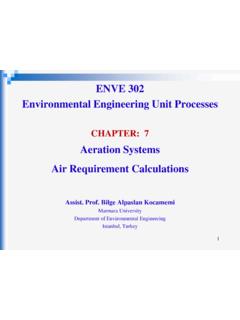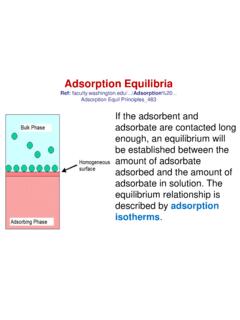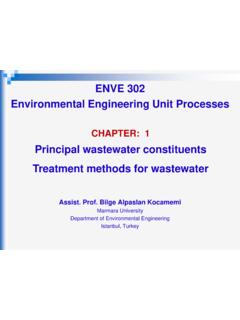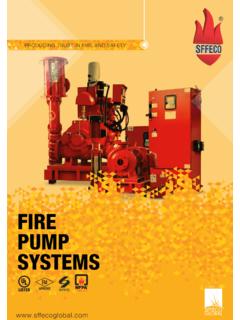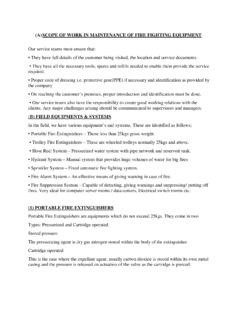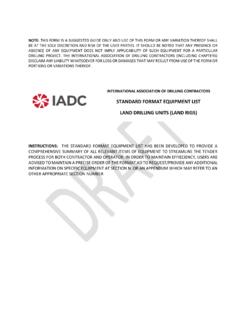Transcription of CHAPTER 8 WATER DISTRIBUTION SYSTEMS - Marmara
1 CHAPTER 8 WATER DISTRIBUTION SYSTEMS DISTRIBUTION system is a network of pipelines that distribute WATER to the consumers. They are designed to adequately satisfy the WATER requirement for a combination of o Domestic o Commercial o Industrial o fire fighting purposes. A good DISTRIBUTION system should satisfy the followings: o Adequate WATER pressure at the consumer's taps for a specific rate of flow ( , pressures should be great enough to adequately meet consumer needs). o Pressures should be great enough to adequately meet fire fighting needs. o At the same time, pressures should not be excessive because development of the pressure head brings important cost consideration and as pressure increases leakages increases too.
2 Note: In tower buildings, it is often necessary to provide booster pumps to elevate the WATER to upper floors. o Purity of distributed WATER should be maintained. This requires DISTRIBUTION system to be completely WATER -tight. o Maintenance of the DISTRIBUTION system should be easy and economical. o WATER should remain available during breakdown periods of pipeline. System of DISTRIBUTION should not such that if one pipe bursts, it puts a large area without WATER . If a particular pipe length is under repair and has been shut down, the WATER to the population living in the down-stream side of this pipeline should be available from other pipeline. o During repairs, it should not cause any obstruction to traffic.
3 In other words, the pipelines should not be laid under highways, carriage ways but below foot paths. DISTRIBUTION SYSTEMS A. Branching pattern with dead end. B. Grid pattern C. Grid pattern with loop. A. Branching Pattern with Dead End Main (trunk) line Sub-main Sub-main Branches Reservoir Similar to the branching of a tree. It consists of o Main (trunk) line o Sub-mains o Branches Main line is the main source of WATER supply. There is no WATER DISTRIBUTION to consumers from trunk line. Sub-mains are connected to the main line and they are along the main roads. Branches are connected to the sub-mains and they are along the streets. Lastly service connections are given to the consumers from branches. Advantages: It is a very simple method of WATER DISTRIBUTION .
4 Calculations are easy and simple to do. The required dimensions of the pipes are economical. This method requires comparatively less number of cut-off valves. However, it is not usually favored in modern WATER works practice for the following disadvantages. Disadvantages: The area receiving WATER from a pipe under repair is without WATER until the work is completed. In this system, there are large number of dead ends where WATER does not circulate but remains static. Sediments accumulate due to stagnation of the dead end and bacterial growth may occur at these points. To overcome this problem drain valves are provided at dead ends and stagnant WATER is drained out by periodically opening these valves but a large amount of WATER is wasted.
5 It is difficult to maintain chlorine residual at the dead ends of the pipe. WATER available for fire - fighting will be limited since it is being supplied by only one WATER main. The pressure at the end of the line may become undesirably low as additional areas are connected to the WATER supply system. This problem is common in many less-developed countries. B. Grid Pattern Reservoir Main line In grid pattern, all the pipes are interconnected with no dead-ends. In such a system, WATER can reach any point from more than one direction. Advantages: Since WATER in the supply system is free to flow in more than one direction, stagnation does not occur as readily as in the branching pattern.
6 In case of repair or break down in a pipe, the area connected to that pipe will continue to receive WATER , as WATER will flow to that area from the other side. WATER reaches all points with minimum head loss. At the time of fires, by manipulating the cut-off valves, plenty of WATER supply may be diverted and concentrated for fire - fighting . Disadvantages: Cost of pipe laying is more because relatively more length of pipes is required. More number of valves are required. The calculation of pipe sizes are more complicated. C. Grid Pattern with Loops Loops are provided in a grid pattern to improve WATER pressure in portions of a city (industrial, business and commercial areas). Loops should be strategically located so that as the city develops the WATER pressure should be sustained.
7 The advantages and disadvantages of this pattern are the same as those of the grid pattern. DESIGN CONSIDERATIONS Diameter 80 mm. For pipes with fire hydrants 100 mm. Velocity > m/sec. Common range is - m/sec. If velocity < m/sec (due to minimum diameter limit) then drain valve is used on that pipe. Minimum pressure at the top of the highest floor of a building is about 5m. According to ller Bankas Regulation: Population 50000 then (P/ )min =20 m. Population 50000 then (P/ )min =30 m It is assumed that tower buildings have their own booster pump. Maximum static pressure = (P/ )max =80 mwc (commonly). Design flow rate = Qmax_hr + Qfire Q fire : According to ller Bankas Regulation, fire flow and fire storage amount can be calculated as.
8 If the future population 10000 fire flow for main line = 5 L/sec fire flow for sub-mains = 5 L/sec fire flow for branches = L/sec It is assumed that 1 fire with a duration of 2 hours then amount of WATER necessary for fire - fighting in the service reservoir: If 10000 < the future population 50000 fire flow for main line = 10 L/sec fire flow for sub-mains = 5 L/sec fire flow for branches = L/sec It is assumed that 2 fires with a duration of 2 hours then amount of WATER necessary for fire - fighting in the service reservoir: If the future population 50000 fire flow for main line = 20 L/sec fire flow for sub-mains = 10 L/sec fire flow for branches = 5 L/sec It is assumed that 2 fires with a duration of 5 hours then amount of WATER necessary for fire - fighting in the service reservoir: fire hydrants are used on sub-mains to provide a connection for fire hoses to fight fire .
9 fire hydrants should be located at easily accessible locations. In Turkey, length of fire hosed is about 50-75m. Therefore, distance between fire hydrants is about 100-150m. Sub-mains should be divided into sections and valves should be provided in each, so that any section may be taken out of operation for repairs. For this purpose, gate valves are usually used. 3 gate valves are used at all crosses. 2 gate valves are used at al tees. To remove air from pipelines or to allow automatic air entrance when the pipeline is emptied (in order to prevent vacuum), air release and relief valves are placed at high points. HYDRAULIC ANALYSIS OF DISTRIBUTION SYSTEMS Most commonly methods used are: a) Dead-end method b) Hardy-Cross method c) Equivalent pipe method A) Dead-End Method Determine the locations of "dead-ends" providing that WATER will be distributed in the shortest way.
10 At the dead-end points there will be no flow DISTRIBUTION . To apply dead-end method for loop SYSTEMS , convert it to branch system. To do this, a dead-end point is identified for each loop. The location of dead end point is chosen such that distance travelled to reach dead-end point from 2 different directions will almost equal to each other. Because; in a closed loop Reservoir Dead-end Dead-end Loop system Branch system Qbegin Qend Dead-end Start calculations from dead-ends to service reservoir. Calculate the total flowrate to be distributed (Qmax_h + Qfire) To calculate design flowrate of each pipe; o Q distributed o Q begin o Q end should be calculated.


